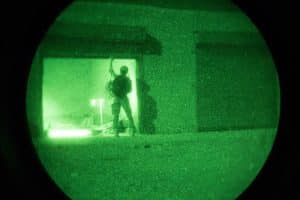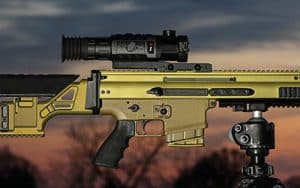
By PR-Tech (Portland, Or.)
The night vision scope has revolutionized and changed the world as we know it. From war to security, and even entertainment, seeing in the dark has grown into a multi-billion dollar industry. With dozens of night vision scopes out on the market, it can be challenging to find the right one for you.
Buying an expensive scope will guarantee you’re getting a good one, but you’ll want to ensure it’s the right one for you. Some scopes operate with infrared light while others use thermal imaging. Some have Bluetooth technology that might complicate things or make your life easier if you know how to use it. Here are a few things we think you should look out for when choosing your night vision scope.
1. Magnification
Some night vision scopes let you zoom in on your target at a distance. Depending on the range of your rifle, you’ll want a scope with a zoom to match. Not all zooms are the same either. Some scopes let you zoom at fixed distances like 2x, 8x, etc… while others let you zoom in at any range between its maximum and minimum ranges. Not all scopes will zoom at variable ranges, but will instead zoom in at fixed ranges. The iRay Mini Thermal Monocular for example has a 1x magnification but is enhanced by 8x digital zoom.
Higher magnification scopes can also blur the resolution the further you look, so you’ll want a scope with a higher resolution. Also consider non-magnified scopes, known as fixed scopes could be a good option as well if you’re low on budget.
2. Infrared vs Thermal
View through an infrared night vision scope
Infrared scopes (known as I2 or night vision) enhance light in low-light conditions. They can also convert infrared light into visible light. These scopes come in two kinds, active and passive. Passive scopes simply enhance the existing light. It’s like turning up the volume, but for light instead of sound. Active infrared scopes shine an infrared light, which is invisible to the human eye, toward the target. This light is picked up by your scope and converted into visible light.
Passive scopes are good for low light conditions, but may not work as well on nights without any moonlight, and are not effective in caves or unlit buildings. Active scopes will work better in complete darkness, but they can have some drawbacks. For example, in a forested area, infrared light could shine too bright on nearby trees. This makes it more difficult to see targets further away.
Thermal scopes create an image based on the temperature of the object. Warmer objects like hogs, deer, or elk will appear brighter, while colder objects like a pond or a tree will appear darker. Light will not affect what a thermal scope picks up. Thermal scopes like the N-Vision HALO LR also have the benefit of working during the day, while I2 or night vision scopes are not as effective.
3. Range Finder

Crosshairs target the range in this range finder thermal scope
Range finder scopes like the iRay BOLT use an infrared laser light that detects how far a target is from you. Knowing the distance of your target can help you get your sights and scope locked in before taking that first shot. These do require more battery power, so keep that in mind.
4. Weight and size
The weight of your thermal or night vision scope is an important factor to consider. If you plan on being in the prone position with a tripod, it shouldn’t be an issue. But if you plan to move around a lot or shoot in the standing position, then you’ll want a lightweight scope. Also, consider that a lighter scope may not have as much magnification power.
Another consideration is the size of the lens. Larger lenses have a more narrow FOV (field of view) and more distance, while a smaller lens has a wider FOV but a shorter distance. Here’s a quick overview of FOV:
5. Battery Life
This will be a big factor when you start to consider how long you’ll be using your scope. Some night vision scopes have internal rechargeable batteries like the iRay BOLT riflescope, which has a battery life of 10+ hours. Other scopes like the Pulsar Trail 2 LRF come with a rechargeable interchangeable battery pack.
6. Night vision scope mounts
Thermal scope attached with a quick-release mount
Some night vision rifle scopes are unmounted or mounted on other things. Some thermal night vision scopes like the N-Vision NOX Thermal Sight can be mounted on a helmet and used as a monocular. Other scopes like the iRay RICO Micro RH25 are conveniently made to double as a handheld scope. The versatility of these scopes can be great if you have a spotter who needs a scope or if you’re walking through the woods during the night.
7. Wifi/Bluetooth and Extras
Do you want a night vision scope to double as a video camera? Because a lot of scopes, like the N-Vision HALO-X, come with this exciting feature. Some scopes require a memory stick to capture your footage while some have internal memory which uses a USB connection to transfer the files to your computer.
Other scopes like the Pulsar Thermion come with Wifi connectivity as well as a downloadable App for your phone. The app lets you control your night vision scope remotely. With the AGM Rattler TS, you can transfer your footage directly over Wifi.
Many night vision rifle scopes are rated for water resistance. Like the Trijicon IR-Hunter 2 which can be submerged under 1 meter of water for up to an hour.
Final Tips
One more thing to keep in mind is thermal imaging front attachments. This is an accessory that simply attaches to your existing daytime scope and converts it into a night vision thermal scope. Like the Pulsar Krypton FXG50, which works with most popular scopes. A device like this could be the upgrade you’re looking for.
Lastly, not all night vision scopes are created equal. It’s important to do your research to find out which scope or attachment will work best for you. The latest scope, with all the bells and whistles, could be too complicated or heavy for what you need. A simple and reliable state-of-the-art night vision scope could be just what you need.




